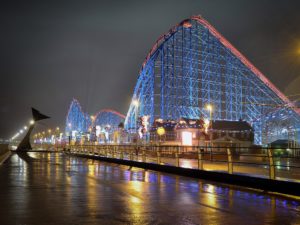You’re suddenly rethinking your decision as you find yourself 456 feet above the ground on the world’s tallest roller coaster—Kingda Ka at Six Flags Great Adventure. Perhaps you don’t have time to think about it though since before you can catch your breath, you’re already plummeting down in a 270-degree spiral. Within your 50-second ride, you travel over 3,000 feet and reach a top speed of 128 mph. This roller coaster is not for the faint of heart!
So how does a thrilling roller coaster experience come to be? It all begins with advanced planning. Roller coaster designers use the knowledge of math, specifically polynomials, to create an experience that meets specific requirements.

Imagine you’re a roller coaster designer entrusted with the task of designing the next big attraction for a nearby theme park. Some criteria for your coaster includes a starting height of 200 ft, dive below ground level at 3 seconds into the ride, return to ground level at 5 seconds, and another dive beneath the ground 10 seconds later.
Where do you begin? Read on because you’ll find the answer to this question and many more in this module. At the end of the module, we’ll return to your design problem so you can come up with a plan.
Candela Citations
- Why It Matters: Power and Polynomial Functions. Authored by: Lumen Learning. License: CC BY: Attribution
- Roller Coaster at Night. Authored by: tshirtevolution. Located at: https://pixabay.com/en/roller-coaster-blackpool-england-1519818/. License: CC BY: Attribution
